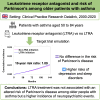Effect of leukotriene receptor antagonist use on the future risk of Parkinson's disease in older patients with asthma
- PMID: 40994822
- PMCID: PMC12455039
- DOI: 10.1093/braincomms/fcaf340
Effect of leukotriene receptor antagonist use on the future risk of Parkinson's disease in older patients with asthma
Abstract
Current treatments for Parkinson's disease focus on symptom management, with no therapies yet demonstrated to slow disease progression. Leukotriene receptor antagonists, widely used for asthma, have shown potential neuroprotective effects for Parkinson's disease in preclinical studies, but have also been associated with an elevated risk of neuropsychiatric events and sleep disorders. We assessed the effect of leukotriene receptor antagonist treatment on the risk of Parkinson's disease, neuropsychiatric events, and sleep disorders in patients with asthma aged over 50 years. We conducted a cohort study using the UK Clinical Practice Research Datalink between January 2000 and December 2020. The study emulated sequential target trials (n = 140) using observational data, comparing leukotriene receptor antagonist treatment to no leukotriene receptor antagonist treatment among patients aged 50-84 years with asthma. The primary outcome was the risk of incident Parkinson's disease, and the secondary outcomes were neuropsychiatric events (anxiety, depression, and psychosis), and sleep disorders. Propensity score matching was employed to minimize confounding. We used pooled logistic regression models to calculate risk ratios as observational analogues of intention-to-treat and per protocol effects. A total of 97 049 matched pairs were included in the analysis, with 573 Parkinson's disease cases observed in the leukotriene receptor antagonist group and 537 in the nonleukotriene receptor antagonist group over a median follow-up of 5.9 years and 5.7 years, respectively. No significant difference in Parkinson's disease risk was observed between the two groups in either the intention-to-treat analysis [10-year risk ratio: 1.09; 95% confidence interval (CI), 0.94-1.26] or the per protocol analysis (10-year risk ratio: 0.95; 95% CI, 0.75-1.16). However, there was a higher risk of depression (intention-to-treat effect: 10-year risk ratio: 1.12; 95% CI, 1.07-1.16; number-needed-to-harm = 93; per protocol effect: 10-year risk ratio: 1.15; 95% CI, 1.08-1.22; number-needed-to-harm = 75) and sleep disorders (intention-to-treat effect: 10-year risk ratio: 1.14; 95% CI, 1.11-1.19; number-needed-to-harm = 77; per protocol effect: 10-year risk ratio: 1.12; 95% CI, 1.06-1.19; number-needed-to-harm = 88) with leukotriene receptor antagonist treatment. No clear effect was observed for anxiety or psychosis. Leukotriene receptor antagonist treatment was not associated with an altered risk of Parkinson's disease among people aged 50-84 years with asthma but was linked to a higher incidence of neuropsychiatric events.
Keywords: Parkinson’s disease; asthma; leukotriene receptor antagonist; target trial emulation.
© The Author(s) 2025. Published by Oxford University Press on behalf of the Guarantors of Brain.
Conflict of interest statement
A.S. reports research funding or support from University College London, National Institute of Health, National Institute for Health Research UCLH Biomedical Research Centre, the International Parkinson and Movement Disorder Society, the European Commission, Parkinson's UK, GE Healthcare, and the Economic and Social Research Council; honoraria for consultancy from Biogen, Abbvie, Roche, Bial, Otsuka and GE Healthcare; and license fee payments from the University College London. Royalties from Oxford University Press. C.C. receives a salary from Newcastle University, University of Plymouth, University Hospitals Plymouth NHS Trust and Parkinson’s UK. C.C. has received advisory, consulting, or lecture fees from AbbVie Inc, Bial, Roche, Mission Therapeutics, InMuneBio, Britannia and Merz, and research funding from Cure Parkinson’s, Edmond J. Safra Foundation, National Institute of Health and Care Research, Michael J Fox Foundation and Parkinson’s UK. T.F. is supported by the NIHR UCLH/UCL Biomedical Research Centre at the UCL Institute of Neurology. L.W. reports receiving grants from the National Institute Health Research-Research for Patient Benefit, Hong Kong Innovation and Technology Commission, Diabetes UK, and British Oncology Pharmacy Association-Pharmacy Research UK (BOPA-PRUK) outside the submitted work. All other authors report no conflict of interest.
Figures



References
-
- Parkinson's UK . The incidence and prevalence of Parkinson’s in the UK: Results from the clinical practice research datalink summary report. 2018. https://www.parkinsons.org.uk/sites/default/files/2018-01/CS2960 Inciden...
-
- Gumber A, Ramaswamy B, Ibbotson R, et al. Economic, social and financial cost of Parkinson's on individuals, carers and their families in the UK: Final report. 2017. https://shura.shu.ac.uk/15930/
LinkOut - more resources
Full Text Sources
